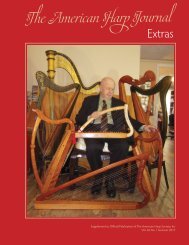The American Harp Journal - Extras - Summer 2018
Supplement to Vol. 26 No. 3 (Summer 2018) of The American Harp Journal
Supplement to Vol. 26 No. 3 (Summer 2018) of The American Harp Journal
Create successful ePaper yourself
Turn your PDF publications into a flip-book with our unique Google optimized e-Paper software.
Ann Hobson Pilot: An Appreciation<br />
by Emily Laurance<br />
I<br />
N my last years at Oberlin, my teacher, Alice<br />
Chalifoux, began to engage me in discussions<br />
about where I should go to continue my training.<br />
Or rather, she told me what she thought I ought<br />
to do.<br />
“You should study with Ann,” she said. Miss<br />
Chalifoux did not tell me that I should continue with<br />
her, but that didn’t bother me: Miss Chalifoux was<br />
sensitive to her students’ individual personalities. I<br />
trusted her to determine the best fit for me, and she<br />
saw something that would respond well to Ann’s<br />
tutelage. But she pointedly instructed me: “you must<br />
never call her Ann; you must always call her Miss<br />
Hobson.” I had been brought up to use honorifics,<br />
so I would never have questioned the formality. But<br />
Miss Chalifoux felt it necessary to emphasize this<br />
point, since she herself spoke always of “Ann”—her<br />
former student. So, pleased with my own correctness,<br />
I made sure to address her as “Miss Hobson” when I<br />
auditioned for her that spring. “I am Mrs. Pilot now,”<br />
she gently corrected me. I was slightly embarrassed<br />
but struck by her direct, formal bearing.<br />
That was my first introduction to Ann Hobson<br />
Pilot: correct, measured, polite. But before we even<br />
met, I was aware of Mrs. Pilot’s career. After graduating<br />
from CIM in 1966 she had performed with the<br />
Pittsburgh and the National Symphonies and was<br />
then invited to audition in Boston. Although moving<br />
to Boston meant playing second to Bernard Zighera,<br />
it also meant playing principal for the Pops under<br />
Arthur Fiedler—an especially high-profile position,<br />
as the Pops had a regular national broadcast on<br />
public television via WGBH. In those same years I<br />
was starting to mature as a young harpist; I saw Mrs.<br />
Pilot regularly on the Pops broadcasts, and she was<br />
L. to R. Emily Laurance, Ann Pilot, Prentiss Pilot. Cleveland,<br />
<strong>2018</strong>.<br />
a prominent feature of them. Whoever edited the<br />
footage anticipated each showy glissando in the lush<br />
orchestrations that typified the Pops. Each time the<br />
camera focused on Mrs. Pilot—not with a close-up<br />
of her hands or a shot from behind, but directly on<br />
her face, with all its concentration and close attention<br />
to detail. <strong>The</strong> camera fully saw her: one of the<br />
few young women and the only African <strong>American</strong><br />
in the orchestra. In the midst of that middlebrow atmosphere,<br />
audience, and repertoire, there was something<br />
refreshingly new about her, as though the longstanding<br />
musical traditions that I trained in were, at<br />
bottom, big enough to include everyone.<br />
Mrs. Pilot’s high-profile performing career sometimes<br />
overshadowed her reputation as a teacher.<br />
At the New England Conservatory we were all in<br />
awe of her, not only as a musician, but as a person.<br />
We noticed all her sartorial choices—not flashy,<br />
but elegant and often streamlined. We particularly<br />
2 THE AMERICAN HARP JOURNAL – EXTRAS




